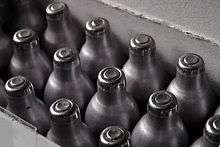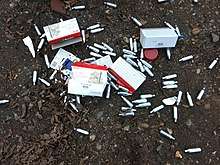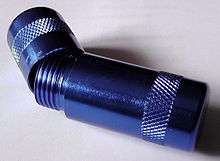Whipped-cream charger
A whipped cream charger is a steel cylinder or cartridge filled with nitrous oxide (N2O) that is used as a whipping agent in a whipped cream dispenser. The narrow end of a charger has a foil covering which is broken to release the gas. This is usually done by a sharp pin inside the whipped cream dispenser. The nitrous oxide in chargers is also used as an oxidizer in hybrid model rocket engines.
Nitrous oxide is a popular recreational drug, and whipped cream chargers are a convenient source of the gas. Among users, the chargers are colloquially called whippits, whippets, nossies or nangs.[1]
The associated kitchen appliance which receives the charger is commonly known as a whipping siphon.
Description

The cylinders are about 6.3 cm (2.5 inches) long and 1.8 cm (0.7 inches) wide, and are rounded at one end with a narrow tip at the other end. The chargers' walls are about 2 mm (about 1/16 inch) thick to withstand the great pressure of the gas contained within. Their interior volume is 10 cm3 (about 0.6 in³) and most brands contain 8 g of N2O under pressure. Used chargers are non-refillable, but 100% recyclable where steel recycling programs exist.
Production
In Europe, where production and use of whip cream chargers originated, there are presently three factories involved in its production. Standard size for whipped cream chargers is eight grams of nitrous oxide per cartridge.
Application
Whipped cream chargers are intended for low-volume or occasional use, such as home kitchens, restaurants, and coffee shop applications.
For very high volume commercial use, there do exist regulated tank systems for filling much larger containers and dispensing more whipped cream. These are more desirable if volume is in excess of a production level of ten litres per hour.
Uses
Culinary
Nitrous oxide is used because it dissolves easily into the cream, and does not cause the cream to oxidize while it is in the can. Cream must have a minimum fat content of 28% to produce whipped cream with a dispenser. The recipe for the cream to be whipped typically calls for heavy cream and sugar, along with any desired flavorings or colorings. In a sealed container, this cream is pressurized with nitrous oxide, which dissolves into the cream as per its lipophilicity.
When the cream dispenser's valve is opened, the cream solution is expelled by the high pressure inside. The change in pressure causes some of the dissolved gas to return to bubbles, effectively fluffing up the cream. Nitrous oxide is bacteriostatic (it inhibits bacteria growth), so a charged cream dispenser can be kept in the refrigerator for up to two weeks.[2]
Recreational drug

Because of their availability, chargers are usually the method of choice for users seeking to use nitrous oxide recreationally.[3] Tanks of medical grade nitrous are difficult to obtain, and auto-grade nitrous contains substances such as sulfur dioxide to prevent human consumption. Chargers are cheaply available in many stores and online.

To inhale from a charger, users either fill a balloon using a cracker, or fill an empty whipped cream dispenser and inhale from it, or likewise use it to fill a balloon, since the potentially rapid rush of gas from the spout of the dispenser may be too harsh. Inhaling directly from a cracker is particularly dangerous due to the risk of developing frostbite on the inside of the mouth or oesophagus.[4][5] The 8 gram nitrous oxide steel cylinder charger when discharged into an empty whipped cream dispenser (Mosa Corp, Taiwan) creates a pressure of 30 pounds per square inch (200kPa) and delivers 3.24 litres of nitrous oxide gas.[6]
Model rocketry
Whipped cream chargers are also used by model rocket enthusiasts for micro hybrid engines, where it acts as an oxidizer for solid fuels such as polyethylene or HTPB.
See also
References
- "Doctors warn of dangerous rise in use of 'nangs'". ABC News (Australia). Australian Broadcasting Corporation. 19 October 2017. Retrieved 12 February 2019.
- "Safety". CreamHub. Retrieved 2019-11-20.
- "Erowid Nitrous Vault : Nitrous Use Among Erowid Visitors". www.erowid.org. Retrieved 2019-11-20.
- Hwang, JC; Himel, HN; Edlich, RF (1996). "Frostbite of the face after recreational misuse of nitrous oxide". Burns. 22 (2): 152–3. doi:10.1016/0305-4179(95)00090-9. PMID 8634126.
- "Obtaining Nitrous Oxide". justsayn2o.com. Retrieved 2019-11-20.
- Sellers, W. F. S. (2016-10-01). "Misuse of anaesthetic gases". Anaesthesia. 71 (10): 1140–1143. doi:10.1111/anae.13551. ISSN 1365-2044. PMID 27393489.
External links
| Wikimedia Commons has media related to Nitrous oxide. |